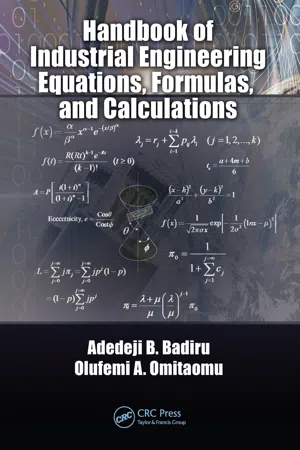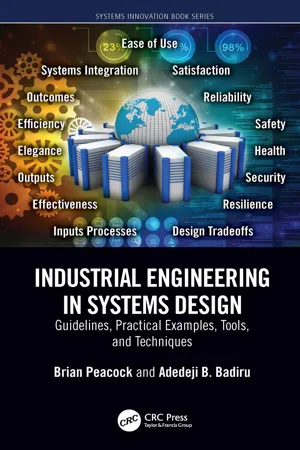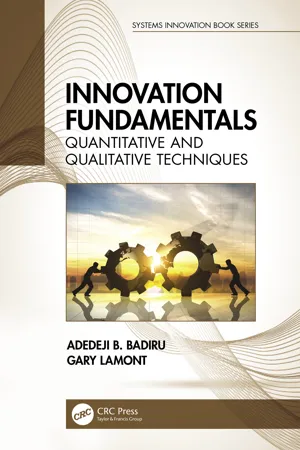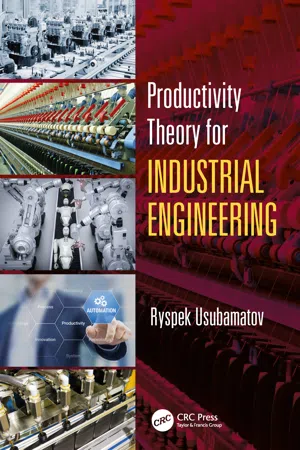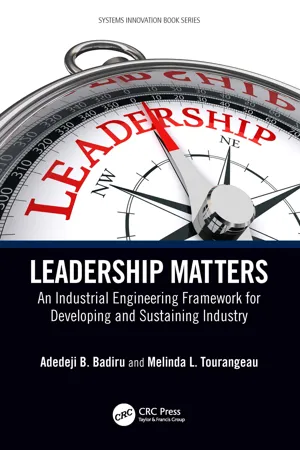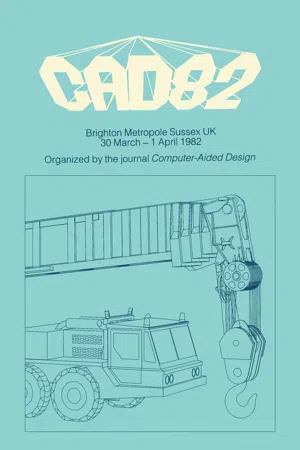Technology & Engineering
Industrial Engineering
Industrial Engineering is a branch of engineering that focuses on optimizing complex systems, processes, and organizations. It involves the application of mathematical and scientific principles to design, improve, and manage systems that involve people, materials, information, and energy. The goal is to increase efficiency, productivity, and quality while reducing waste, costs, and risks.
Written by Perlego with AI-assistance
Related key terms
1 of 5
10 Key excerpts on "Industrial Engineering"
- No longer available |Learn more
- (Author)
- 2014(Publication Date)
- Orange Apple(Publisher)
____________________ WORLD TECHNOLOGIES ____________________ Industrial Engineering Industrial Engineering is a branch of engineering dealing with the optimization of complex processes or systems. It is concerned with the development, improvement, implementation and evaluation of integrated systems of people, money, knowledge, information, equipment, energy, materials, analysis and synthesis, as well as the mathematical, physical and social sciences together with the principles and methods of engineering design to specify, predict, and evaluate the results to be obtained from such systems or processes. Its underlying concepts overlap considerably with certain business-oriented disciplines such as Operations Management, but the engineering side tends to emphasize extensive mathematical proficiency and usage of quantitative methods. Depending on the sub-speciality(ies) involved, Industrial Engineering may also be known as operations management, management science, operations research, systems engineering, or manufacturing engineering, usually depending on the viewpoint or motives of the user. Recruiters or educational establishments use the names to differentiate themselves from others. In health care, industrial engineers are more commonly known as health management engineers or health systems engineers. While the term originally applied to manufacturing, nowadays the term industrial in Industrial Engineering can be somewhat misleading (some engineering universities and educational agencies around the world have changed the term “industrial” to the broader term “production”, leading to the typical extensions noted above). It has grown to encompass any methodical or quantitative approach to optimizing how a process, system, or organization operates. - Adedeji B. Badiru, Olufemi A. Omitaomu(Authors)
- 2010(Publication Date)
- CRC Press(Publisher)
The discipline embraces both the technical and managerial approaches in solving complex problems. Because of their integrated nature, IE solutions are robust and sustainable. Principles of IE are applicable to all areas of human endeavor. The essence of IE is captured in the official definition below: Industrial Engineer —one who is concerned with the design, installation, and improvement of integrated systems of people, materials, information, equipment, and energy by drawing upon specialized knowledge and skills in the mathematical, physical, and social sciences, together with the principles and methods of engineer-ing analysis and design to specify, predict, and evaluate the results to be obtained from such systems. The above definition embodies the various aspects of what an industrial engineer does. For several decades, the military, business, and industry have called upon the dis-cipline of IE to achieve program effectiveness and operational efficiencies. IE is versatile, flexible, adaptive, and diverse. It can be seen from the definition that a systems ori-entation permeates the work of industrial engineers. This is particularly of interest to contemporary organizations, where operations and functions are constituted by link-ing systems. The major functions and applications of industrial engineers include the following: • Designing integrated systems of people, technology, process, and methods. • Modeling operations to optimize cost, quality, and performance trade-offs. • Developing performance modeling, measurement, and evaluation for systems. • Developing and maintain quality standards for government, industry, and business. • Applying production principles to pursue improvements in service organizations. • Incorporating technology effectively into work processes. • Developing cost mitigation, avoidance, or containment strategies. • Improving overall productivity of integrated systems of people, tools, and processes.- eBook - ePub
Industrial Engineering in Systems Design
Guidelines, Practical Examples, Tools, and Techniques
- Brian Peacock, Adedeji B. Badiru(Authors)
- 2023(Publication Date)
- CRC Press(Publisher)
Using systems-thinking approaches, IE makes direct contributions to teamwork, structural communication, critical thinking, smart design, impact assessment, operational literacy, and social responsibility. The above definition embodies the various aspects of what an industrial engineer does. As can be seen, the profession is very versatile, flexible, and diverse. It can also be seen from the definition that a systems orientation permeates the work of industrial engineers. Some of the major functions of industrial engineers involve the following:- Design integrated systems of people, technology, process, and methods.
- Develop performance modeling, measurement, and evaluation for systems.
- Develop and maintain quality standards for industry and business.
- Apply production principles to pursue improvements in service organizations.
- Incorporate technology effectively into work processes.
- Develop cost mitigation, avoidance, or containment strategies.
- Improve overall productivity of integrated systems of people, materials, and processes.
- Recognize and incorporate factors affecting performance of a composite system.
- Plan, organize, schedule, and control production and service projects.
- Organize teams to improve efficiency and effectiveness of an organization.
- Install technology to facilitate workflow.
- Enhance information flow to facilitate smooth operations of systems.
- Coordinate materials and equipment for effective systems performance.
IE makes systems function better together with less waste, better quality, and fewer resources. The goal of every organization is to eliminate waste. Thus, the above definition is aptly relevant for everyone. IE can be described as the practical application of the combination of engineering fields together with the principles of scientific management. It is the engineering of work processes and the application of engineering methods, practices, and knowledge to production and service enterprises. IE places a strong emphasis on understanding of workers and their needs in order to increase and improve production and service activities. IE activities and techniques include the following: - eBook - ePub
Innovation Fundamentals
Quantitative and Qualitative Techniques
- Adedeji B. Badiru, Gary Lamont(Authors)
- 2021(Publication Date)
- CRC Press(Publisher)
7Innovation through Industrial Engineering Techniques
INTRODUCTION TO NEXUS OF Industrial Engineering AND INNOVATION
Innovation is not a physical product, but a mindset to find a better way to accomplish an objective. This is why we feel passionate about the application of the tools and techniques of Industrial Engineering, a profession dedicated to “finding a better way” to accomplish any objective. The objective may be along the realm of technology, process, and workforce improvement. Some of the pertinent definitions of Industrial Engineering include the following:Industrial engineers make systems function better together with less waste, better quality, and fewer resources.Below is the official definition from the Institute of Industrial and Systems Engineering:Industrial engineers deal with systems. They can design, implement or improve integrated systems comprised of people, materials, information or energy. Industrial Engineering can develop a better way of doing just about anything.Industrial engineers find innovative ways to solve complex problems. In all spheres of organizational pursuits in government, business, industry, the military, and hospitals, Industrial Engineering makes things happen more efficiently.Industrial Engineer – one who is concerned with the design, installation, and improvement of integrated systems of people, materials, information, equipment, and energy by drawing upon specialized knowledge and skills in the mathematical, physical, and social sciences, together with the principles and methods of engineering analysis and design to specify, predict, and evaluate the results to be obtained from such systems.EVOLUTION OF INNOVATION IN SOCIETY
The diverse need of the society for innovation is the reason why Industrial Engineering is needed. This fact has been highlighted by various publications on Industrial Engineering over the years, including Emerson and Naehring (1988) , Zandin (2001) , Martin-Vega (2001) , Salvendy (2001) , Sink et al (2001) , Badiru and Thomas (2009) - Adedeji B. Badiru(Author)
- 2013(Publication Date)
- CRC Press(Publisher)
Throughout this chap-ter, these two fields are used together and the discussions that follow are applicable to either. Perhaps the first classic and widely accepted definition of Industrial Engineering (IE) was offered by the then American Institute of Industrial Engineering (AIIE) in 1948. 2 Others have extended the definition. “Industrial Engineering is uniquely concerned with the analysis, design, installation, control, evaluation, and improvement of sociotechnical systems in a manner that protects the integrity and health of human, social, and natural ecologies. A sociotechnical system can be viewed as any organization in which people, materials, information, equipment, procedures, and energy interact in an integrated fash-ion throughout the life cycles of its associated products, services, or programs (see foot-note 2). Through a global system’s perspective of such organizations, Industrial Engineering draws upon specialized knowledge and skills in the mathematical, physical, and social sciences, together with the principles and methods of engineering analysis and design, to specify the product and evaluate the results obtained from such systems, thereby assuring such objectives as performance, reliability, maintainability, schedule adherence, and cost control (Figure 10.2). As shown in Figure 10.2, there are five general areas of industrial and systems engineer-ing. Each of these areas specifically makes out some positive contributions to the growth of industrial and systems engineering. The first area shown in the diagram is twofold, and comprises sociology and economics. The combination of the knowledge from these two areas helps in the area of supply chain. The second area is, mathematics, which is a powerful tool of ISEs. Operations research is an important part of this area. The third area is psychology, which is a strong pillar for ergonomics. Accounting and economics both 1 http://www.orie.cornell.edu/~IIE. 2 http://www.iienet.org.- eBook - ePub
- Ryspek Usubamatov(Author)
- 2018(Publication Date)
- CRC Press(Publisher)
The term Industrial Engineering comprises a wide area of engineering that deals with the optimisation of complex processes and systems, and leads to eliminate wastage of production time, decrease machine time and decrease energy consumption and other resources that do not generate value. In addition, industrial engineers figure out how to better engineering processes and systems that improve quality and productivity. Industrial Engineering encompasses a range of specialised fields of engineering, particularly areas of technologies and production machineries that focus on high output with high quality. This is a main part of economic activity of industrial companies that represents the critical success factor of production systems. To define optimal engineering solutions and to describe mathematical models for productivity of manufacturing machines and systems, the concepts involved in it are primary important problems in production systems.The main purpose underlying any production process is to strive for productivity and profitability, which are typically specified concepts of efficiency. Production is a system of combining various technological processes, information, machinery and material inputs of production to manufacture products for consumption. All production systems are processes that transform resources into useful goods and are based on application of labour, equipment, materials, land, buildings, etc. The technological processes constitute the works in the preparatory, machining and assembly stages of manufacture, and finally the finished goods characterise a typical production system. The technological processes subject to the constraints of the capacity of the production system, which are limited by the nature of physics of technology and quality of products, limit the system’s ability to meet output expectations. The management of technological processes, i.e. the planning and control of the production system to achieve acceptable outputs, is an important task of the production manager.The productivity of the manufacturing system and the quality of products are major factors in determining the efficiency of production systems. Some researchers have deliberated productivity as a phenomenon in production processes. They suggest that the measurement of productivity in production processes shall be developed so that it will indicate an increase or decrease in the productivity of the company. Researchers regard the measurement of productivity rate as an important part of the productivity phenomenon and solve the problems related to measuring it at a long time. - eBook - PDF
- Avraham Shtub, Yuval Cohen(Authors)
- 2015(Publication Date)
- CRC Press(Publisher)
2 Introduction to Industrial Engineering completion. The design is in a language understood by construction work-ers, purchasing agents, suppliers, subcontractors, quality control experts, and so on. 1.1.2 Industrial Engineering According to the Merriam-Webster dictionary, IE deals with the design, improvement, and installation of integrated systems (as of people, materials, and energy) in the industry. Modern IE is concerned with the design, management, and control of operational processes. For that purpose, IE combines classical knowledge in physics, mathematics, computing, and statistics with tools for incorporating the human factor, ergonomics, sociology, and psychology. For example, in the design of a new business branch, industrial engineers plan the work packages and their allocation to operators. Industrial engi-neers also design the work positions using their knowledge of ergonomics, facility layout planning, and efficient work planning. 1.1.3 Industrial Engineers Industrial engineers design organizational processes and perform projects and ongoing activities that may involve facilities, products, and systems. The facilities, products, systems, and processes are used to supply products or services. Industrial engineers often focus on processes that take into account the human factor. For designing organizational processes, industrial engi-neers collaborate with managers and their subordinates, and sometimes with peers, such as engineers (e.g., mechanical engineers, electrical engi-neers, software engineers, etc.). An industrial engineer is also involved in determining how to best utilize the resources of the organization. Resources such as workers, raw materials, capital, information, buildings, equipment, energy, and technological knowl-edge are used by industrial engineers to perform their tasks. Industrial engi-neers translate the goals of the organization, the constraints imposed, and the uncertainty, to find the best solutions for the organization. - eBook - ePub
- Dimitri Uzunidis, Fedoua Kasmi, Laurent Adatto(Authors)
- 2021(Publication Date)
- Wiley-ISTE(Publisher)
The first definition, established in 1955 and revised in 1985 by the Institute of Industrial Engineers, states that “Industrial Engineering” is concerned with the design, improvement and implementation of integrated systems of human resources, materials, equipment and energy. It uses knowledge and know-how in mathematics, physics and social sciences, as well as the principles and methods of analysis and design relevant to the art of engineering, in order to predict and evaluate the results that can be expected from such systems.Although the term “design” is used twice in this definition, practice shows that this definition is very production-oriented. As a result, in the United States, we have seen the emergence of “engineering management” from management schools, which focuses more on the technological lifecycle (Cleland et al. 1981).In France, the concept of Industrial Engineering (IE) arrived in 1975 to face economic pressures and to solve problems of optimizing the organization of production systems in terms of price, quantity, quality and flexibility. More generally, it deals with the topics of production management, product/process design and project management and thus marks a first step in responding to the problem of optimizing industrial processes (design process, manufacturing, inventory management, quality, planning, marketing, etc.). It is an interdisciplinary application of the models and tools of the feeder disciplines to the problems of industrial organization (e.g. the contributions of statistics to quality control, or those of mathematics to production scheduling).In the 1980s, increasing globalized competitive pressure led to the search for decisive competitive advantages, in particular by working on the integrated design of products, processes, production tools and marketing strategies to reduce lead times and become increasingly responsive to the environment.This is how industrial systems engineering (ISE) was born, integrating the dimensions of “production sciences”, “design sciences” and “project management”, thus combining the approaches of Industrial Engineering and engineering management. More generally, the idea is to consider a more global vision and to work on enlarged study objects (e.g. moving from flow optimization to optimization of the organization of the industrial system or from product design to activity design). This has led to a change in the level of approach to problems both in their spatio-temporal and cultural dimensions. In addition, the obsolescence or decline of entire areas of industrial and service activity (metallurgy, coal mining, traditional trade) associated with the emergence of new technologies, the evolution of consumption and the internationalization of markets has led to the increasingly acute and rapid need for the creation of new activities. - eBook - ePub
Leadership Matters
An Industrial Engineering Framework for Developing and Sustaining Industry
- Adedeji B. Badiru, Melinda L. Tourangeau(Authors)
- 2023(Publication Date)
- CRC Press(Publisher)
Industrial engineers, with a systems-thinking approach, help answer and solve all these operational wonderments. IE thrives on systems perspectives just as systems thrive on IE approaches. One cannot treat IE topics effectively without recognizing a systems perspectives and vice versa. Thus, it makes sense to have a leadership book that is based on the foundational principles of IE.The formal definition of IE presented in this chapter embodies the various aspects of what an industrial engineer does. The definition is versatile, flexible, and diverse. It can also be seen from the definition that a systems orientation permeates the work of industrial engineers. Some of the major functions of industrial engineers involve the following:- Design integrated systems of people, technology, process, and methods.
- Develop performance modeling, measurement, and evaluation for systems.
- Develop and maintain quality standards for industry and business.
- Apply production principles to pursue improvements in service organizations.
- Incorporate technology effectively into work processes.
- Develop cost mitigation, avoidance, or containment strategies.
- Improve overall productivity of integrated systems of people, materials, and processes.
- Recognize and incorporate factors affecting performance of a composite system.
- Plan, organize, schedule, and control production and service projects.
- Organize teams to improve efficiency and effectiveness of an organization.
- Install technology to facilitate workflow.
- Enhance information flow to facilitate smooth operations of systems.
- Coordinate materials and equipment for effective systems performance.
An IE colleague, Susan Blake (at Tinker Air Force Base in Oklahoma City), once succinctly defined the profession as “Industrial Engineering makes systems function better together with less waste, better quality, and fewer resources.”Leveraging a systems approach is a cornerstone of IE. To remind, a system is a collection of interrelated elements whose collective output is higher than the sum of the individual outputs. So, what is a systems approach? A systems approach, as we define it here, is the recognition that no pursuit should be executed in isolation. Everything interacts with something else, either through interdependencies or through interrelationships. It is through this recognition that everything within the scope of a goal or objective (people, tools, or process) is interconnected to something else. This facilitates a more robust appreciation of what each element brings to the organizational table. Although there may be differing definitions and interpretations of the systems approach, the same basic message is embedded as we have articulated it in the explanation above. Even more importantly, integration, the cornerstone of the DEJI Systems Model (Badiru, 2014 - eBook - PDF
CAD82
5th International Conference and Exhibition on Computers in Design Engineering
- Alan Pipes(Author)
- 2017(Publication Date)
- Butterworth-Heinemann(Publisher)
Essentially the industrial engineer specifies the process by which the product is to be manufactured, the facilities that will be deployed, the method by which each stage of the manufacturing process will be carried out and determines the work content involved. Often all or part of this procedure is executed iteratively on a speculative basis prior to production in a pre-production planning and estimating exercise. As a consequence of this innovative work, the Industrial Engineering department originates a lot of information which is vital to the functioning and management of the manufacturing organisation as a whole, in areas such as shop floor super-vision, production control, costing, etc. Usually, the Industrial Engineering department also acts as the repository of this information, which may include machining data, workplace layouts, preferred methods, work content values and work measurement records and standards. Access to this information is exercised at two levels: * Access by staff within the Industrial Engineering department who need to USE the information for, say, studying new jobs, planning for new products, balancing production lines, etc. * Access by staff external to the Industrial Engineering department making ENQUIRIES who need limited information for the purposes of estimating, production planning and control, shop floor supervision, labour costing,etc. Usually ENQUIRERS obtain access to the Industrial Engineering records via the USERS thus interrupting, distracting and delaying the Industrial Engineering staff. One of the prime objectives of Industrial Engineering is the optimisation of the effectiveness of the manufacturing process, both in the initial definition of the process and as a continuing review - an objective which has gained even s
Index pages curate the most relevant extracts from our library of academic textbooks. They’ve been created using an in-house natural language model (NLM), each adding context and meaning to key research topics.

